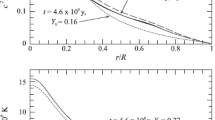Abstract
Two sunspot models are compared-shallow and deep. According to the former, a sunspot, as a region occupied by a strong regular field and comparatively cold plasma, penetrates into the solar convection zone to a shallow depth of about 4 Mm. This corresponds to both local seismology data and a series of compelling theoretical arguments. The deep model supposes that the sunspot magnetic field penetrates to the bottom of the convective zone, with the monotone increasing with depth without being turbulized, where it attains a strength of higher than 150 kG. It is shown that the deep model contradicts some basic concepts of solar physics and cannot be an alternative to the shallow sunspot model.
Similar content being viewed by others
References
Basu, S., Antia, H.M., and Bogart, R.S., Ring-diagram analysis of the structure of solar active region, Astrohys. J., 2004, vol. 610, pp. 1157–1168.
Bogart, R.S., Basu, S., Rabello-Soares, M.S., and Antia, H.M., Probing the subsurface structure of active regions with ring-diagram analysis, Solar Phys., 2008, vol. 251, pp. 439–451.
Gizon, L., Schunker, H., Baldner, C.S. et al. (15 coauthors), Helioseismology of sunspots: a case study of NOAA region 9787, Space Sci. Rev., 2008, vol. 144, nos. 1–4, pp. 249–273.
Grinin, V.P., Theory of radiative heat exchange in polytropic atmosphere, Astrofizika, 1972, vol. 8, no. 1, pp. 53–70.
Kitchatinov, L.L. and Mazur, M.V., Stability and equilibrium of emerged magnetic flux, Solar Phys., 2000, vol. 191, pp. 325–340.
Kosovichev, A.G., Duvall, T.L., Jr., and Scherrer, P.H., Time-distance inversion methods and results, Solar Phys., 2000, vol. 192, pp. 159–176.
Kosovichev, A.G., Subsurface characteristics of sunspots, Adv. Space Res., 2006, vol. 38, pp. 876–885.
Kosovichev, A.G., Photospheric and subphotospheric dynamics of emerging magnetic flux, Space Sci. Rev., 2009, vol. 144, pp. 175–195.
Kosovichev, A.G., Local helioseismology of sunspots: Current status and perspectives, Solar Phys., 2012, vol. 279, pp. 323–348.
Moradi, H. and Cally, P.S., Time-distance modeling in a simulated sunspot atmosphere, Solar Phys., 2008, vol. 251, pp. 309–327.
Moradi, H., Hanasoge, S.M., and Cally, P.S., Numerical models of travel-time inhomogeneities in sunspots, Astrophys. J., 2009, vol. 690, pp. L72–L75.
Moradi, H., Baldner, C., Birch, A.C., et al., (22 coauthors), Modeling the subsurface structure of sunspot, Solar Phys., 2010, vol. 267, pp. 1–62.
Obridko, V.N., Sunspots and Complexes of Activity, Moscow: Nauka, 1985.
Parker, E.N., The nature of the sunspot phenomenon. I: Solutions of the heat transport equation, Solar Phys., 1974, vol. 36, pp. 249–274.
Parker, E.N., Sunspots and the physics of magnetic flux tubes, Astrophys. J., 1979a, vol. 230, pp. 905–923.
Parker, E.N., Cosmical Magnetic Fields. Part I, Oxford: Claredon Press, 1979b.
Ponomarenko, Yu.B., Mechanism for the formation of sunspots, Soviet Astron., 1972, vol. 16, pp. 116–120.
Rempel, M., Numerical sunspot models: Robustness of photospheric velocity and magnetic field structure, Astrophys. J., 2012, vol. 750, pp. 62–83.
Schlüter, A. and Temesvary, S. The internal constitution of sunspots, in Electromagnetic Phenomena in Cosmical Physics, IAU Sympos., Lehnert, B., Ed., Cambridge University Press, 1958, vol. 6, pp. 263–285.
Solov’ev, A.A., Energetic of sunspot, Bull. Solhechnye Dannye, 1976, no. 4, pp. 54–60.
Solov’ev, A.A., An elementary energetic model of a sunspot, Soviet Astron., 1984, vol. 28, pp. 447–451.
Solov’ev, A.A., Problem of sunspot dissipation, Soviet Astron., 1991, vol. 35, no. 1, pp. 83–87.
Solov’ev, A.A. and Kirichek E.A., Subsurface structure of sunspots, Astronomy Reps., 2009, vol. 53, pp. 675–683.
Solov’ev, A.A. and Kirichek, E.A., Basic properties of sunspots: equilibrium, stability and eigen oscillations, Astrophys and Space Sci., 2014, vol. 352, pp. 23–42.
Zhao, J., Kosovichev, A.G., and Duval, T.L., Investigation of mass flows beneath a sunspot by time-distance helioseismology, Astrophys. J., 2001, vol. 557, pp. 384–388.
Author information
Authors and Affiliations
Corresponding author
Rights and permissions
About this article
Cite this article
Solov’ev, A.A., Kirichek, E.A. The sunspot—shallow or deep?. Geomagn. Aeron. 54, 915–919 (2014). https://doi.org/10.1134/S0016793214070123
Received:
Published:
Issue Date:
DOI: https://doi.org/10.1134/S0016793214070123




